Diversity and Dynamics in Hispanic Serving Community Colleges: A Comparative Study

Hispanic-Serving Institutions (HSIs) have become increasingly essential in enhancing college accessibility and degree completion for Hispanic students, particularly within community colleges (Laden, 2010). These HSIs are identified by federal standards as public or private institutions that offer both two-year and four-year programs and have a Latino student enrollment of 25% or more.
Over the past several decades, there has been a notable growth in the Hispanic and Latino/a student population at postsecondary institutions in the United States. Latino/a student representation has surged from 4% in 1980 to approximately 20% by 2020, with a significant 3.7 million Latinos enrolled. Public two-year institutions have become increasingly popular among Latino/a students, with 37% attending these schools in 2022 (Mora, 2022; Nam, 2023).
Given their pivotal role in facilitating access to higher education for a diverse and growing Hispanic population, a review into Hispanic-Serving Community Colleges within the U.S. is crucial. These institutions are central to advancing educational equity and inclusivity, and they provide valuable perspectives on how community colleges can effectively support minority students, low-income and first-generation college attendees. By analyzing the Hispanic-Serving Community Colleges’ geographic locations, institutional affiliation, student demographics, approaches to financial aid, and rates of student success desegregated by institutional affiliations, educational leaders can pinpoint the areas requiring enhancement. Such research is imperative for shaping educational policies, steering administrative tactics, and ensuring that these community colleges adapt to the changing educational requirements of Hispanic students, thereby contributing to the broader aims of the U.S. education system.
Therefore, my study focuses on exploring the differences between private for-profit, private not-for-profit, and public Hispanic-Serving Community Colleges. This includes understanding how these various types of institutions differ in their key features and demographics, and how these differences affect student graduation outcomes. For this purpose, I'm using data from the 2021-2022 academic year provided by IPEDS, comparing these different types of colleges to better understand their impact on student success.
Based on the data, we can see that smaller-sized institutions, especially private for-profits with fewer than 1,000 students, are predominant across 377 colleges.:
| Control Of Institution | Institution Size Category | Total Number of Colleges | % of Total Colleges |
|---|---|---|---|
| Private for-profit | Under 1,000 | 127 | 34% |
| 1,000 - 4,999 | 19 | 5% | |
| Private not-for-profit | Under 1,000 | 10 | 3% |
| Public | Under 1,000 | 10 | 3% |
| 1,000 - 4,999 | 71 | 19% | |
| 5,000 - 9,999 | 73 | 19% | |
| 10,000 - 19,999 | 58 | 15% | |
| 20,000 and above | 11 | 3% | |
| Grand Total | 377 | 100% |
California and Texas have highest geographic concentration:
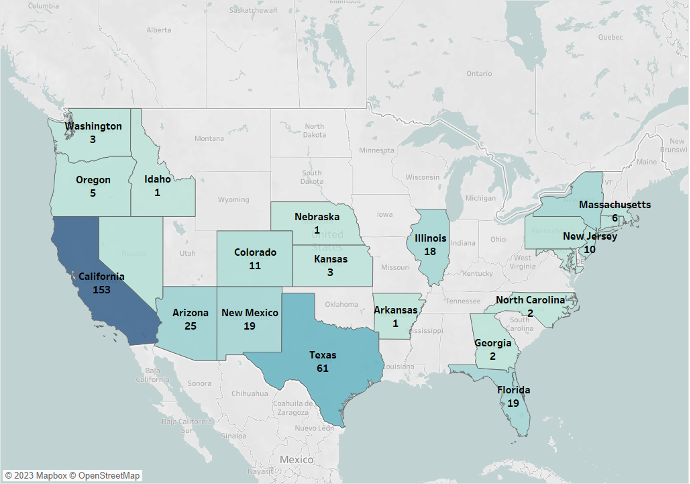
The map illustrates the geographic spread of Hispanic-Serving Community Colleges in the United States. California has the most with 153 colleges. Texas ranks second with 61, and Arizona has 25. In contrast, Idaho, Nebraska, and Arkansas each have only one such college. On the east coast, the numbers are more modest, with Massachusetts hosting 6 and New Jersey hosting 10. In the Pacific Northwest, Oregon has 5 Hispanic-Serving Community Colleges and Washington has 3.
Institutions show distinct enrollment patterns across gender and racial groups:
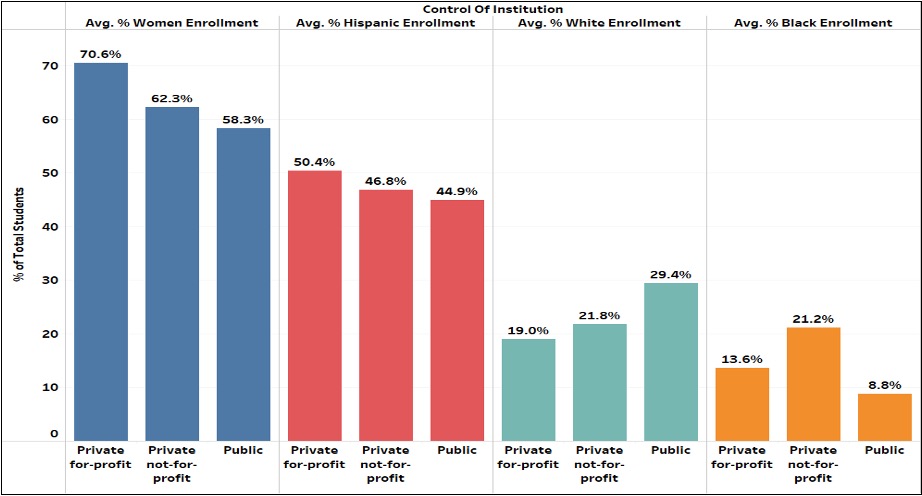
Private for-profit institutions lead in both women's and Hispanic enrollment rates, while private not-for-profits have the greatest proportion of white and black students. Public institutions, despite having the lowest enrollment percentages for women, Hispanics, and blacks, have the highest enrollment of white students. Overall, there is a clear variation in enrollment demographics across institutional types.
Diverse Financial Aid Approaches in Private and Public Colleges:
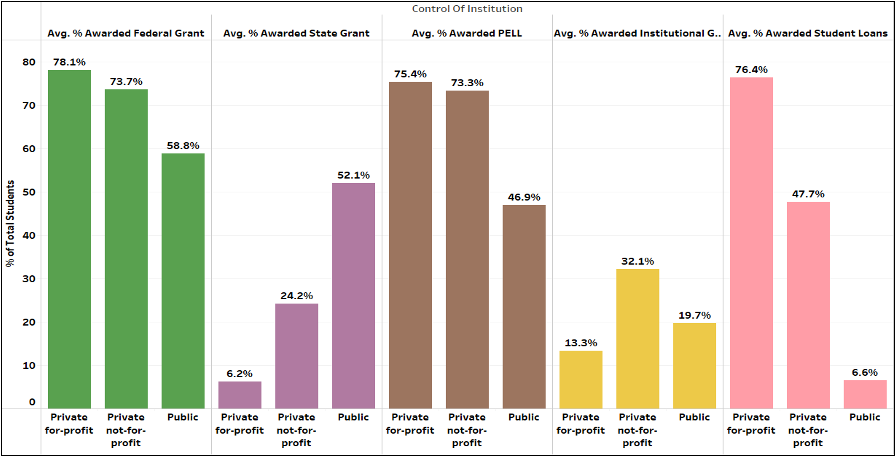
Private for-profit colleges lead in federal and PELL grant aid, with a majority of students also receiving student loans. Private not-for-profits predominantly offer state and institutional grants but less in student loans. Public HSIs provide the most state grant aid but the least federal grants and student loans, underscoring varied financial aid strategies among these institutions.
Distance, Part-Time, and Non-Traditional Student Composition:
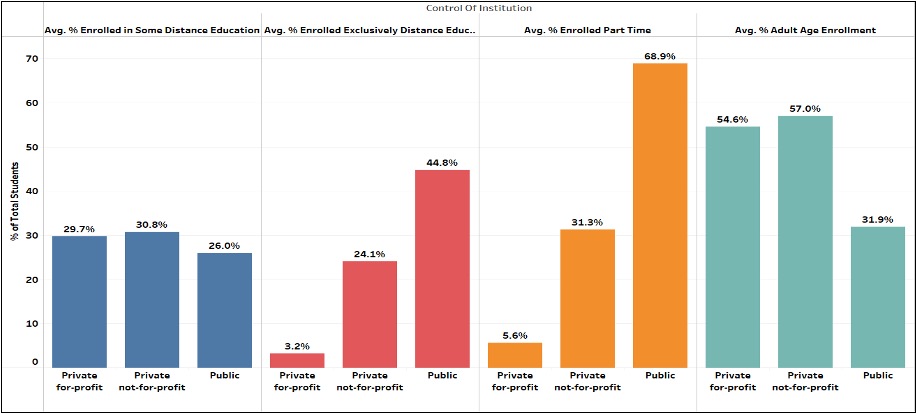
Private for-profit institutions have a significant portion of their students enrolled in some kind of distance education, with a small fraction enrolled exclusively online, a modest number attending part-time, and more than half being adult learners. Private not-for-profit institutions report slightly more students engaged in some form of distance education, with a noticeably larger number exclusively online, a substantial portion of part-time students, and a majority as adult learners. Meanwhile, public institutions, while having fewer students in some form of distance education, see the greatest proportion enrolled exclusively online and the highest rate of part-time attendance, but they have a smaller percentage of adult learners compared to the other types of institutions.
Private institutions with open admission policy generally show higher graduation rates whereas public institutions following open admission policy show lower graduation rates, especially for PELL recipients.:
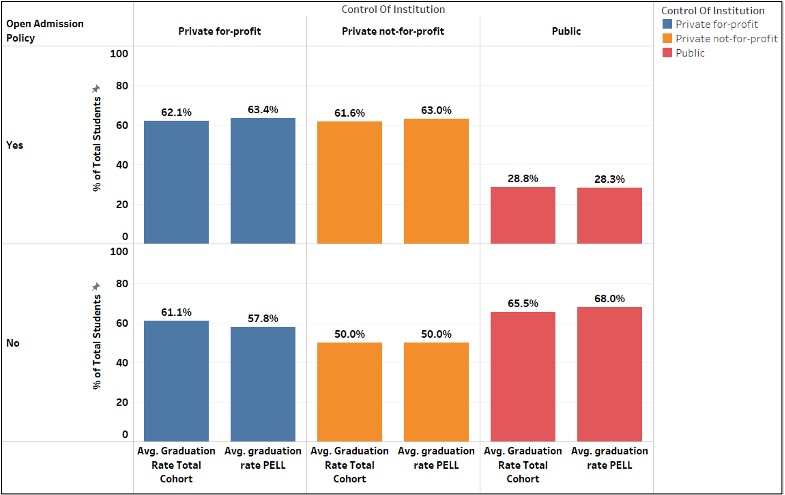
In institutions without open admissions, private for-profits and public institutions tend to have higher graduation rates than private not-for-profits. However, when open admissions policies are in place, private for-profits and not-for-profits show an increase in graduation rates, whereas public institutions experience a significant decline. The pattern is consistent for PELL recipients, where private institutions maintain or improve graduation rates under open admissions, but public institutions see a marked decrease. Overall, the presence of open admissions policies appears to positively affect graduation rates in private institutions while having the opposite effect on public institutions.
Overall Findings:
- Hispanic Serving Community Colleges in the U.S. are predominantly smaller institutions, especially within the private for-profit sector.
- There is a geographical concentration in states like California and Texas, with fewer HSIs on the east coast and in some other states.
- Private for-profit Hispanic Serving Community Colleges show higher enrollment rates for women and Hispanic students.
- Private not-for-profit Hispanic Serving Community Colleges tend to enroll more white and black students.
- Public institutions enroll the mostly white students but have lower percentages of women, Hispanics, and blacks.
- Financial aid strategies differ, private for-profits depend more on federal and PELL grants and student loans, while private not-for-profits offer more state and institutional grants, and public colleges provide the most state grant aid but less federal support.
- Private institutions have a higher participation in distance education, but public institutions lead in the proportion of students exclusively learning online and in part-time enrollment.
- Private institutions that follow open admission policies tend to show higher graduation rates, whereas public colleges, when implementing the same policy, typically experience lower graduation rates.
References:
Bailey, T, Alfonso, M, Calcagno, J, Jenkins, D, Kienzl, G & Leinbach, T 2004, Improving student attainment in community colleges: institutional characteristics and policies, Community College Research Center, New York, viewed 18 Nov 2023, http://ccrc.tc.columbia.edu/DefaultFiles/SendFileToPublic.asp?ft=pdf&FilePath=c:Websitesccrc_tc_columbia_edu_documentsÚ_209.pdf&fid=332_209&aid=47&RID=209&pf=Publication.asp?UID=209.
Cohen, A. M. (1984). Hispanic students and transfer in the community college. Paper presented at the Hispanic Roundtable Talk of the American Association of Community and Junior Colleges, Phoenix, AZ.
Dembicki, M. (2023, July 24). Completion gap widens for Latino students - Community College Daily. Community College Daily - American Association of Community Colleges. https://www.ccdaily.com/2023/07/completion-gap-widens-for-latino-students/
Laden, B. (2010). Hispanic-Serving Institutions: What Are They? Where Are They? Community College Journal of Research and Practice, 28(3). https://doi.org/10.1080/10668920490256381.
Mora, L. (2022, November 7). Hispanic enrollment reaches new high at four-year colleges in the U.S., but affordability remains an obstacle. Retrieved November 17, 2023, from https://www.pewresearch.org/short-reads/2022/10/07/hispanic-enrollment-reaches-new-high-at-four-year-colleges-in-the-u-s-but-affordability-remains-an-obstacle/
Nam, J. (2023, September 8). Hispanic and Latino/a Students in Higher Education: Facts and Statistics. BestColleges. Retrieved November 17, 2023, from https://www.bestcolleges.com/research/hispanic-college-students-statistics/#fn-ref-1.
Núñez, A., Sparks, P. J., & Hernández, E. (2010). Latino Access to Community Colleges and Hispanic-Serving Institutions: A National Study. American Association of Hispanics in Higher Education. https://vtechworks.lib.vt.edu/server/api/core/bitstreams/5365301e-def6-4497-86b1-a96b56dd4684/content
Palabra. (2023, October 2). Community Colleges Offer Affordable Alternative for Latino Students Seeking Bachelor’s Degrees. Gulflive. https://www.gulflive.com/palabra/2023/09/community-colleges-offer-affordable-alternative-for-latino-students-seeking-bachelors-degrees.html
 Mashref Hoque is a Business Analyst professional in the higher education sector. Previously, he worked in the capacity of Business Intelligence and Reporting Analyst Weber State University. He earned his MA in Financial Economics from Bowling Green State University, Ohio. He can be reached at mhoque@bgsu.edu.
Mashref Hoque is a Business Analyst professional in the higher education sector. Previously, he worked in the capacity of Business Intelligence and Reporting Analyst Weber State University. He earned his MA in Financial Economics from Bowling Green State University, Ohio. He can be reached at mhoque@bgsu.edu.
